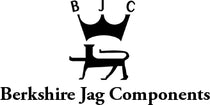When you think of British automotive brands, you probably think of Jaguar. Known for its blend of elegance, innovation and performance, Jaguar has really made a mark on the industry. From early racing cars to luxury sedans and SUVs seen today, Jaguar has focused on evolution and resilience, and a commitment to crafting vehicles that excite drivers. Below, we’ve taken a look at how Jaguar has changed over the years, from its conception in 1922 to the cars we see today.
Jaguar’s Journey Over the Years
- The Birth of Jaguar - Jaguar was founded in 1922 the Swallow Sidecar Company by William Lyons and William Walmsley in Blackpool. Initially, the company specialised in producing motorcycle sidecars but quickly pivoted to creating custom car bodies. In 1935, the company rebranded as SS Cars Ltd., and launched the SS Jaguar line shortly after.
-
1940s and 1950s - After World War II, the SS name was dropped and the brand was officially renamed Jaguar Cars Ltd. In 1948, Jaguar introduced the Jaguar XK120, a sports car that set new standards in performance and design. Equipped with a powerful 3.4-litre inline-six engine, the XK120 was the fastest production car of its time, achieving speeds of up to 120 mph. The XK120’s successor, the Jaguar C-Type, made its mark in racing around this time, winning the 24 Hours of Le Mans in 1951 and 1953.

Image from: davidsclassiccars.com - 1960s - In 1960s, Jaguar released one of the most iconic sports cars of all time, the Jaguar E-Type. Debuting in 1961, the E-Type was celebrated for its stunning design, advanced engineering and performance. With a top speed of 150 mph and an impressive 3.8-litre inline-six engine, the E-Type offered a combination of beauty and power rarely seen at the time. The E-Type’s design evolved over the years, with a 4.2-litre engine introduced in later models.
- 1970s and 1980s - During the 1970s, Jaguar faced challenges due to financial pressures and a changing market, but despite these difficulties, Jaguar continued to produce memorable cars, including the Jaguar XJ series. The XJ6 and XJ12 saloons were luxurious, powerful and elegant and the XJ-S, introduced in 1975, brought a powerful V12 engine.
- 1990s - In 1990, Jaguar was bought by Ford Motor Company and under Ford’s ownership, Jaguar introduced several new models, including the Jaguar XK8 and Jaguar XKR. These were both equipped with V8 engines, moving away from the six-cylinder engines previously used. Jaguar also began to expand into new markets, introducing more advanced safety features, refined luxury interiors, and innovations in handling and comfort.
-
2000s - In 2008, Jaguar was acquired by Tata Motors. This saw the introduction of the Jaguar XF, a stylish sedan that combined Jaguar’s heritage with modern styling and technology. The Jaguar XJ was reimagined in 2010 with an aluminium body and a focus on high tech luxury, and the F-Type was launched in 2013 as a modern sports car inspired by the E-Type.

Image from: amazingcarsanddrives.com - Modern Day - In recent years, Jaguar has embraced electrification and sustainability, introducing the all electric Jaguar I-PACE in 2018. The I-PACE is an electric luxury SUV, and it received critical acclaim for its impressive range, quick acceleration and refined design. This marks Jaguar’s commitment to a greener future, aligning with the global shift towards electric vehicles. Jaguar’s expansion into SUVs also includes the Jaguar F-PACE and E-PACE, offering performance and luxury, while still incorporating the sleek, sporty feel that defines Jaguar.
Jaguar’s Changing Engines
Jaguar has evolved its engine technology over the years, enabling it to stay at the forefront of performance and efficiency. From the inline-six engines in the XK120, to the powerful V12s in the XJ-S and XJ12, Jaguar’s engines have continually reflected advancements in power, smoothness and responsiveness. Under Ford, Jaguar introduced a line of reliable V8 engines, and today, the Ingenium engines in the XE, F-PACE and F-Type provide both power and efficiency. The development of electric technology with the I-PACE blends sustainable energy with impressive performance, positioning Jaguar as a leader in luxury electric vehicles.









